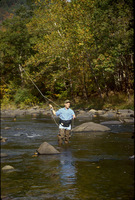 | Back to e-WV
| Back to e-WV
 The West Virginia Encyclopedia
The West Virginia Encyclopedia
 | Back to e-WV
| Back to e-WV
 The West Virginia Encyclopedia
The West Virginia Encyclopedia

With only 101 square miles of natural inland water surface, West Virginia does not possess the abundance of angling opportunities of many other states. But the quality of our fishing is excellent, particularly in size of fish. We grow large muskellunge; we boast a walleye fishery that produces fish comparable in size to those of the prime waters of North America; and three of our smallmouth bass streams are renowned for yielding trophy catches.
There are nearly 40 species of sport fish in West Virginia. One of those is the native brook trout, which has been designated as the state fish. The brook trout is one of four cold water sportfish available in West Virginia, the others being rainbow, brown, and golden rainbow trout. The latter is a mutation of a normal-colored rainbow, discovered in 1955 at the Petersburg trout hatchery in Grant County. It was first stocked in 1963 during West Virginia’s Centennial celebration.
Native ‘‘brookies,’’ colorful fish with yellow and red spots and pink-red fins, were once abundant in the eastern highlands, but their range has diminished because of land use changes. Our remaining native brook trout streams, mostly tiny mountain tributaries, are state treasures. West Virginia’s most storied trout stream is Cranberry River, whose former grandeur has been restored with the building of two limestone treatment facilities to counteract acidity. A limestone station has also restored trout fishing in Blackwater River.
A notable trout fishing development of recent decades has been the addition of several new brown trout fisheries in West Virginia through a cooperative effort by Trout Unlimited and the Division of Natural Resources. The fishing organization and the state agency stocked fingerling-size browns in streams that previously had no trout, and in many cases the stockings have been successful.
The most prized of West Virginia’s large game fish is the muskellunge, once confined to our rivers but which now also inhabits several large impoundments through stocking. West Virginia muskies in the 40-inch class are not uncommon, and a few have topped 50 inches. Muskie fishing in Elk River is legendary. The catch and release of muskies, including very large ones, has become common and has enhanced the quality of the state’s muskie fishing. A mini-industry has grown up around the manufacture of muskie lures by several of our fishermen.
Lester Hayes Jr. of Nitro caught a 52.5-inch, 43-pound muskie in Elk River in 1955. In 1997, Anna Marsh of Buckhannon, fishing from the shoreline at Stonecoal Lake, topped the previous record weight by more than six pounds. Then in 2003, Glenn Boyd of Weston broke the length record with a muskie of 52.7 inches, also from Stonecoal. In 2021, Chase Gibson broke the length record at Burnsville Lake: 54 inches long.
Our walleye fishery does not produce large numbers of this tasty game fish, but 10- to 15-pounders are caught each year. Summersville Lake, Elk River, and Kanawha Falls are favorite walleye waters. The length record for walleye in West Virginia is 35 inches, set by Fred Cline in 1976, at Kanawha Falls. In 2004, Jerry Rose, fishing in the Elk River, caught an 18.97-pound walleye, the heaviest on record in the state.
West Virginia’s premier warm water fish, due to its relative abundance, is the smallmouth bass, a tenacious fighter whose surface acrobatics are a delight. New River, Greenbrier River, and the South Branch are all excellent smallmouth streams. In 1971, David Lindsay, 16, of Wiley Ford, Mineral County, bought a fishing license en route to the South Branch, and caught a nine-pound, 12-ounce smallmouth that remains the heaviest ever caught in the state. The length record is held by Franklin J. Elliott, who caught a 25.5-inch smallmouth in New River in 1976.
The greatest abundance of warm water fish exists in the Ohio and Kanawha rivers, primarily below the navigation locks and dams.
The Division of Natural Resources awards trophy citations for 28 species of fish. In addition to those already named, other notables include largemouth bass, channel catfish, and flathead catfish. The latter is our heavyweight champion, occasionally exceeding 50 or even 60 pounds.
But big isn’t necessarily better with Mountain State anglers. Two of our most popular species are also two of the smallest: crappie and bluegill. The large Army Corps of Engineers and power company lakes boast excellent fishing for these two panfish, as well as for other species. These impoundments have added 18,395 surface acres of fishing in West Virginia. The DNR also owns or manages more than 100 other lakes ranging in size from under 10 acres to more than 300 acres.
Because of his 1940 book Tale of the Elk, which is still popular with readers, lawyer W. E. R. Byrne is one of West Virginia’s best-known fishermen. So too is Eli ‘‘Rimfire’’ Hamrick, the Webster County mountaineer who would, according to legend, hang a ‘‘Gone Fishin’’’ sign on the door of his Webster Springs jewelry store. Chuck Yeager, the legendary pilot, caught his first trout on Cranberry River after returning from World War II.
View a gallery of Sport Fish of West Virginia
Written by Skip Johnson